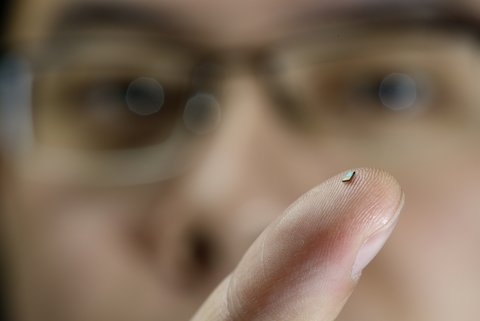Researchers at Eindhoven University of Technology (TU/e) have developed the world’s tiniest temperature sensor that’s powered in a unique way: from the radio waves that are part of the sensor’s wireless network. What this means is that the sensor doesn’t require a single wire, nor a battery that would need replacing. According to the research team, this technology is a likely candidate for the smart buildings of tomorrow.

Pictured above is the world’s tiniest sensor on the finger of PhD student, Hao Gao. Image source: TU/e, Bart van Overbeeke.
Similar to many other forecasters, TU/e envisions a future where smart buildings are filled with sensors and other devices that can gather information and carry out tasks in order to automate the business of living, while also making it more sustainable. But as sensors decrease in size and are incorporated into more things around the home, the issues of powering them without stringing wires everywhere or spending time swapping out batteries remains.
Led by researcher Hao Gao, being that the project is part of his PhD thesis, his sensor very much fits the lightweight category, being 2 sq. mm and weighing just 1.6 mg. Designed to use very little electricity, the sensor absorbs the energy once it’s exposed to radio waves until it stores enough to transmit a signal back to a special router that’s able to target the sensor. The temperature of the sensor alters the frequency of the signal, which the router is able to decode.
According to TU/e, the tiny size and independent nature of the sensor means that it can be placed in all sorts of unorthodox locations, such as in concrete or plaster. Impressively, it can also be mixed with latex and applied directly to walls like paint.
Currently the sensor has an operating range of 1 in., but TU/e hopes to extend this to 3 ft within a year, and ultimately to 5 m. Applications for the wireless sensors include not only smart buildings, but payment systems, wireless ID, and industrial applications.
Source: TU/e
Advertisement
Learn more about Electronic Products Magazine





